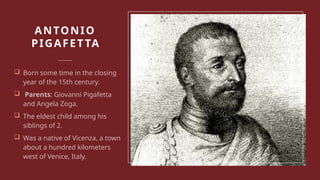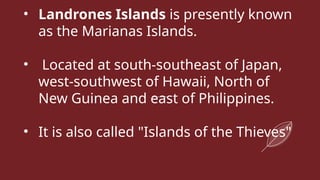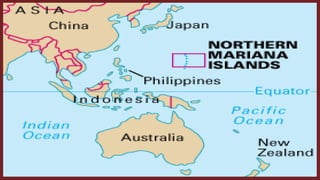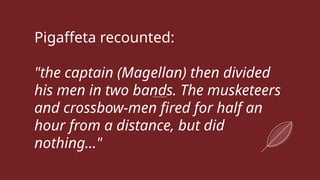A-BREIF-SUMMARY-OF-THE-FIRST-VOYAGE-AROUND-THE-WORLD-BY-MAGELLAN-BY-ANTONIO-PIGA.pptx
- 1. READING IN PHILIPPINE HISTORY Content and Contextual Analysis of Selected Primary Sources in Philippine History
- 2. Learning Objectives: • To familiarize oneself with the primary documents in different historical periods of the Philippines; • To learn history through primary sources; • To properly interpret primary sources through examining the content and context of the document; and • To understand the context behind each selected documents.
- 3. WHAT WE'LL DISCUSS? ☐ A B R I E F S U M M A R Y O F T H E F I R S T V O YA G E A R O U N D T H E W O R L D B Y M A G E L L A N B Y A N T O N I O P I G A F E T TA
- 4. • It is the historian's primary tool of understanding and interpreting the past. • It ascertain historical facts. HISTORICAL SOURCES
- 5. • Facts are then analyzed and interpreted by the historian. • Using primary source in historical research entails two kinds of criticism. HISTORICAL SOURCES
- 6. • EXTERNAL CRITICISM - Authenticity of the document or the evidence being used. • INTERNAL CRITICISM- Examine the truthfulness of the content of the evidence. HISTORICAL SOURCES
- 7. A BRIEF SUMMARY OF THE FIRST VOYAGE AROUND THE WORLD BY MAGELLAN BY ANTONIO PIGAFETTA
- 8. ABOUT THIS BOOK This book was taken from the chronicles of contemporary voyagers, navigator of sixteenth century, and was an Italian nobleman, Antonio Pigafetta.
- 9. ABOUT THIS BOOK Antonio Pigafetta's work instantly became a classic that prominent literary men in the West.
- 10. ABOUT THIS BOOK Pigafetta's travelogue is one of the most important primary source in the study of Pre-Colonial Philippines.
- 11. ABOUT THIS BOOK Antonio Pigafetta's account was also a major referent to the events leading the Magellan's arrival in the Philippines.
- 12. ABOUT THIS BOOK His (Pigafetta) encounter with local leaders, his death with the hands of Lapu-lapu's forces in the battle of Mactan and the departure of what was left of Magellan's fleet from the islands.
- 13. ABOUT THIS BOOK The First Voyage Around the World by Magellan was published after Pigafetta returned to Italy.
- 14. ANTONIO PIGAFETTA Born some time in the closing year of the 15th century. Parents: Giovanni Pigafetta and Angela Zoga. The eldest child among his siblings of 2. Was a native of Vicenza, a town about a hundred kilometers west of Venice, Italy.
- 15. ANTONIO PIGAFETTA Studied astronomy, geography, and cartography. Served on board the ships of the Knights of Rhodes at the beginning of the 16th century. Had an aunt, Elisabetta, who married Valerio Chiericati. Accompanied Monsignor Chiericati to Spain in 1519. Accompanied Ferdinand Magellan, together with Juan Sebatián Elcano in the famous expedition to Moluccas which began in August 1519 and ended in September 1522.
- 16. LET'S START THE JOURNEY In Pigafetta's account, their fleet reached what he called Landrones Island or the "Island of Thieves"
- 17. WHAT IS LANDRONES ISLANDS OR THE ISLANDS OF THIEVES?
- 19. • Landrones Islands is presently known as the Marianas Islands. • Located at south-southeast of Japan, west-southwest of Hawaii, North of New Guinea and east of Philippines. • It is also called "Islands of the Thieves"
- 20. He recounted (Pigafetta): "These people have no arms, but use sticks, which have a fish bone at the end. They are poor, but ingenious, and great thieves, and for the sake of what we called these three islands the Landrones Islands."
- 22. TEN DAYS AFTER
- 23. • Pigafetta reported that they reached what he called the isle of Zamal, now Samar but Magellan decided to land in another uninhabited island for a greater security where they could rest for a few days.
- 24. TWO DAYS AFTER
- 25. • Pigafetta recounted that nine (9) men came to them and showed joy and eagerness in seeing them. In turn, the natives also gave them fish, palm wine (uraca), figs (fruit), two cochos, rice (umai), cocos, and other food supplies.
- 26. "This palm tree produces a fruit named cocho, which is as large as the head, or thereabouts: its first husk is green, and two fingers in thickness, in it they find certain threads, with which they make the cords for fastening their boats."
- 27. • Pigafetta characterized the people as "very familiar and friendly" and willingly showed them different islands and the names of these islands.
- 28. • Humunu Island (Homonhon) and there they found what Pigafetta referred to as the "Watering Place of Good Signs. "FIRST SIGNS OF GOLD IN THE ISLAND."
- 29. • They named the island (Humuno or Homonhon) with the nearby islands as the Archipelago of St. Lazarus.
- 30. • Pigafetta recounted that they saw two ballanghai (balangay), a long boat full of people in Mazzava/Mazaua. • The leader, who referred to as the King of the Ballanghai (Balangay), sent his men to the ship of Magellan.
- 31. • When the King of the Balangay offered to give Magellan a bar of gold and a chest of ginger, Magellan declined. • Magellan sent the interpreter to the king and asked for money for the needs of his ships and expressed that he came into the islands as a friend and not as an enemy.
- 32. • Magellan also boasted of his men in in armor who could not be struck with swords and daggers. • Magellan also shared with the king his charts and maps and shared how they found the islands.
- 33. • Magellan was introduced to the king's brother (Raia Calambu) who was also a king of another island. • The gold was abundant that parts of the ship and of the house of the second king were made of gold. • Pigafetta described this king as the most handsome of all the men that he saw in this place.
- 34. • He was also adorned with silk and gold accessories like a golden dagger, which he carried with him in a wooden polished sheath.
- 35. • This king was named Raia Calambu, King of Zuluan and Calagan (Butuan and Caragua). • The first king was Raia Siagu.
- 37. Which happened to be Easter Sunday, Magellan ordered the chaplain to preside a Mass by the shore. "... when the offertory of the mass came, the two kings, went to kiss the cross like us, but they offered nothing, and at the elevation of the body of the Lord they were kneeling like us, and adored our Lord with joined hands."
- 38. • Magellan ordered that the cross be brought with nails and crown in place. • Cross, Nail, & Crown were the signs of his emperor (Magellan).
- 39. • The king concurred and allowed for the cross to be planted. • This Mass would go down in history as the first Mass in the Philippines, and the cross would be the famed Magellan's Cross still preserved at present day
- 40. • Magellan and his men decided to move and look for islands where they could acquire more supplies and provisions. • They learned of the islands of Ceylon (Leyte), Bohol, and Zzubu (Cebu) and inetended to go there.
- 41. • Raia Calambu offered to pilot them in going to Cebu. Cebu is the largest and richest islands.
- 42. APRIL 7, 1521
- 43. • Magellan and his men reached the port of Cebu. Magellan said that he was a captain of a king himself and thus would not pay tribute to other kings. The king of Cebu consulted his council.
- 44. • Magellan's men and the king of Cebu, together with other principal men of Cebu, met in an open space. • There, the king of Cebu offered a bit of his blood and demanded that Magellan do the same.
- 45. "Then the king said that he was content, and as a greater sign of affection he sent him a little of his blood from his right arm, and wished he should do the like. Our people answered that he would do it. Besides that, he said that all the captains who came to his country had been accustomed to make a present to him, and he to them, and therefore they should ask their captain if he would observe the custom. Our people answered that he would; but as the king wished to keep up the custom, let him begin and make a present, and then the captain would do his duty."
- 46. • Magellan spoke before the people of Cebu about peace and God. Magellan responded to this by saying that his faith entailed children to render honor and obedience to their parents.
- 47. • Magellan also preached about their faith further and people were reportedly convinced. Pigafetta recounted: "their men were overjoyed seeing that the people wished to become Christians through their free will and not because they were forced or intimidated."
- 48. • Magellan spoke to the king (Cebu) and encouraged him to be a good Christian by burning all of the idols and worship the cross instead. The king of Cebu was then baptized as a Christian. Pigafetta wrote: "To that the king and all his people answered that thy would obey the commands of the captain and do all that he told them..."
- 49. Pigafetta wrote: "and when he was baptized, he said that he would name him Don Charles (Carlos), as the emperor his sovereign was named; he named the prince Don Fernand (Fernando), after the brother of the emperor, and the king of Mazavva, Jehan: to the Moor he gave the name of Christopher and to the others each name of his fancy."
- 50. AFTER EIGHT DAYS April 22, 1521
- 51. Pigafetta counted: "all of the island's inhabitant were already baptized. He admitted that they burned a village down for obeying neither the king nor Magellan." The mass was conducted by the shore every day.
- 52. • When the queen came to the Mass one day, Magellan gave her an image of the infant Jesus made by Pigafetta himself. • The king of Cebu swore that he would always be faithful to Magellan.
- 53. • When Magellan reiterated that all of the newly baptized Christians need to burn their idols, but the natives gave excuses telling Magellan that they needed the idols to heal a sick man who was a relative to the king. • Magellan insisted that they should put their faith in Jesus Christ.
- 54. • They went to the sick man and baptized him. After baptismal, Pigafetta recorded that the man was able to speak again. He called this a miracle.
- 55. ON THE 26TH OF APRIL 1521
- 56. • Zula, a principal man from the island of Matan (Mactan) went to see Magellan and asked him for a boat full of men so that he would be able to fight the chief named Silapulapu (Lapulapu).
- 57. • Magellan offered three boats and expressed his desire to Mactan himself to fight the said chief. • Magellan's forces arrived in Mactan in daylight. Zula's company numbered 49 in total and the islanders of Mactan were estimated to number 1500.
- 58. THE BATTLE BEGAN
- 59. Pigaffeta recounted: "When we reached land (Mactan), we found the islanders hundred in number (estimated 1500), drawn up three squadrons; they came down upon us with terrible shouts, two squadrons attacking us on the flanks and the third in front..."
- 61. Pigaffeta recounted: "the captain (Magellan) then divided his men in two bands. The musketeers and crossbow-men fired for half an hour from a distance, but did nothing..."
- 62. Pigaffeta recounted: "since the bullets and arrows, though they passed through their shield made of thin wood, and perhaps wounded their arms, yet did not stop them..."
- 63. Pigaffeta recounted: "the captain shouted not to fire, but he was not listened to..."
- 64. "The islanders seeing that the shots of our guns did them little or no harm would not retire, but shouted more loudly, and springing from one side to the other to avoid our shots, they at the same time drew nearer to us, throwing arrows, javelins, spears hardened in fire, stones, and even mud, so that we could hardly defend ourselves."
- 65. The natives, perceiving that the bodies of the enemies were protected with armors, aimed for their legs instead. Magellan was pierced with a poisoned arrow in his right leg.
- 66. A few of their men charged at the natives and tried to intimidate them by burning an entire village but this only enraged the natives further. Magellan was specifically targeted because the native knew that he was the captain general.
- 67. Magellan was hit with a lance in the face. Magellan retaliated and pierced the same native with his lance in the breast and tried to draw his sword but could not lift it because of his wounded arm. Seeing that the captain has already deteriorated, more natives came to attacked him.
- 69. One native with a great sword delivered a blow in Magellan's left leg, brought his face down and the natives ceaselessly attacked Magellan with lances, swords, and even with their bare hands.
- 71. Pigafetta recounted the last moment of Magellan: "Whilst the Indians were thus overpowering him, several times he turned around towards us to see if we were all in safety, as though his obstinate fight had no other object than to give an opportunity for the retreat of his men."
- 72. Pigafetta also said that the king of Cebu who was baptized could have sent help but Magellan instructed him not to join the battle and stay in the balangay boat so that he would see how they fought.
- 73. The king offered the people of Mactan gifts of any value and amount in exchange of Magellan's body, but the chief refused because they wanted to keep Magellan's body as a memento of their victory.
- 74. Magellan's men elected Duarte Barbosa as the new captain. Pigafetta also told how Magellan's slave and interpreter named Henry betrayed them and told the King of Cebu that they intended to leave as quickly as possible.
- 75. The king invited these men to a gathering where he said he would present the jewels that he would send for the king of Spain.
- 76. Pigafetta was not able to join the twenty-four men who attended because he was nursing his battle wounds. It was only a short time when they heard cries and lamentations. The natives had slain all of the men except the interpreter and Juan Serrano who was already wounded.
- 77. Serrano was presented and shouted at the men in the ship asking them to pay ransom so he would be spared. However they refused and would not allow anyone to go to the shore. The fleet departed and abandoned Serrano.
- 78. They left Cebu and continued their journey around the world
- 79. THANK YOU BRENT ERROL MOLARO, FRANK EMIL BRIONES, ROMMEL SAURANE DISCUSSANce
Editor's Notes
- #62: Pigaffeta recounted: "since the bullets and arrows, though they passed through their shield made of thin wood, and perhaps wounded their arms, yet did not stop them..."














































































